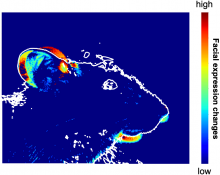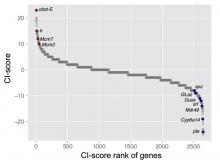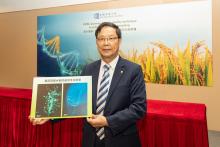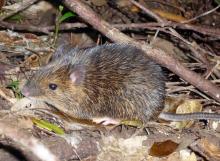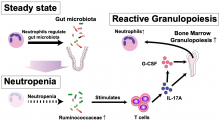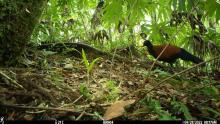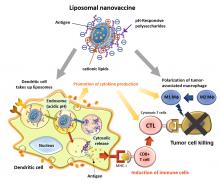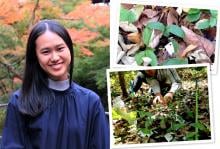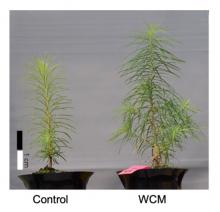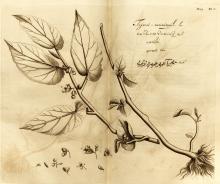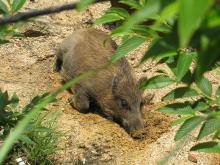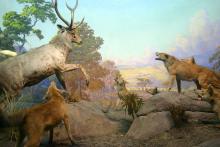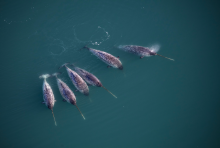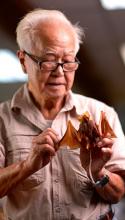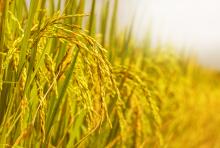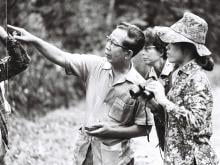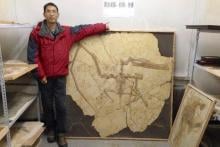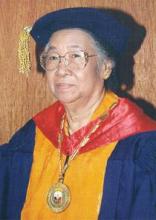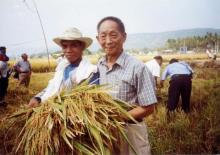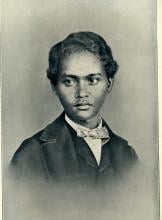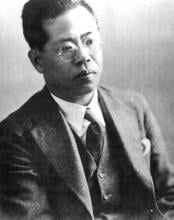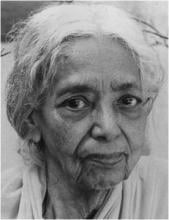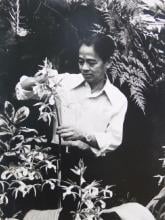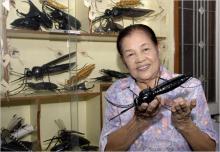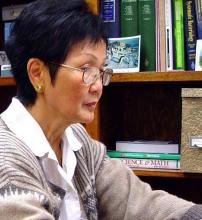Plants & Animals
News
23 Dec 2022
Asia Research News monitors the latest research news in Asia. Some highlights that caught our attention this week are how a wasp uses its genitals to defend itself, a compound commonly found in mushrooms that could delay cognitive decline, and sunshine as a cure for myopia.
16 Dec 2022
Asia Research News monitors the latest research news in Asia. Some highlights that caught our attention this week are how we determine which animals we would eat or not, a robot with sticky magnetic feet that can climb, and coriander seeds that had a great holiday in space.
15 Dec 2022
International research co-authored by The Education University of Hong Kong (EdUHK) found that a major type of marine species can adapt to ocean acidification. Considered a major breakthrough in marine biology research, the findings were recently published in the prestigious academic journal Nature Climate Change.
15 Dec 2022
Understanding how bats tolerate viral infections, Material separates water from...water, The virtual sense of touch polished to next level and COVID-19 negatively impacted early-careers and female researchers. Read all in the December's Editor's Choice.
14 Dec 2022
Using cryogenic electron microscopy, a research team from the Research Center for Artificial Photosynthesis (ReCAP) at Osaka Metropolitan University has revealed, for the first time, the structures and binding environments of pigments bound to a protein called a photosynthetic antenna of the marine green macroalga Codium fragile. The team’s results extend our knowledge about the molecular mechanism by which blue-green light—the only light available in deep seawater—is efficiently utilized for photosynthesis.
11 Dec 2022
Scientists investigate how genes in some insects can influence one another to change their expression depending on environmental conditions.
09 Dec 2022
Asia Research News monitors the latest research news in Asia. Some highlights that caught our attention this week are a coat that can make you invisible to AI cameras, a fossilized whale skeleton found in a river valley, and hope for humans after our Y chromosome disappears.
02 Dec 2022
Asia Research News monitors the latest research news in Asia. Some highlights that caught our attention this week are a “smart ranch” featuring connected cows, a way to see what a 1 600-year-old woman looked like, and a new bird-like dinosaur.
01 Dec 2022
Research led by Hong Kong Baptist University (HKBU) involving the use of a pioneering female sterility technique has led to a breakthrough in the production of hybrid rice seeds. Compared to the commonly used “three-line” male sterility technique in hybrid rice seeds production, the novel approach enhances the efficiency of hybrid rice production by eliminating rice seeds that have been produced due to the self-pollination of the “restorer line”. The novel technique enables fully automatic harvesting of hybrid seeds by machines, which can substantially reduce harvesting costs.
28 Nov 2022
The Sox9 gene is upregulated in the absence of sex-determining Y chromosome and Sry gene in Amami spiny rat.
21 Nov 2022
Intestinal bacteria composition is crucial to driving the recovery of neutrophils counts in the blood of mice following treatments such as stem cell transplants or chemotherapy.
18 Nov 2022
Asia Research News monitors the latest research news in Asia. Some highlights that caught our attention this week are the discovery that rats enjoy music like we do, a microrobot that can tickle small insects, and how dinosaurs’ flight differs from birds.
18 Nov 2022
An expedition with the Search for Lost Birds captured the first-ever photos and video of the black-naped pheasant-pigeon.
11 Nov 2022
Asia Research News monitors the latest research news in Asia. Some highlights that caught our attention this week are a bioinspired tiny jumping robot, evidence of gender stereotypes in young children, and the first sighting of a new species of crab.
31 Oct 2022
A research group at Osaka Metropolitan University has developed a drug delivery system that activates a strong cellular immune response to attack cancer cells, using one-tenth of the amount of antigen needed in the group’s previous work. By incorporating positively charged cationic lipids into liposomes and adding negatively charged pH-responsive polysaccharides to the surface, the research group increased the uptake efficiency of liposomes encapsulating cancer antigens by dendritic cells by approximately five times, which increased cytokine production by about 100 times. This increased M1-type macrophages, which activate cancer immunity, and decreased M2-type macrophages, which promote cancer growth.
28 Oct 2022
Osaka Metropolitan University scientists conducted a 7-year study on seedling recruitment and mortality in a national park in Chiang Mai, in northern Thailand. During the study period, an extremely strong El Niño event occurred, leading to a stronger and longer drought than normal. Seasonally dry tropical forests (SDTFs), which experience an annual dry season, are considered drought-tolerant. Nevertheless, the study found that seedling mortality increased in SDTFs when severe and prolonged drought occurred. The mortality rate was greater in evergreen forests at higher elevations that usually experience less severe drought than in deciduous forests at lower elevations where severe drought is more common. The study results advance the understanding of the effects of El Niño on seedling dynamics in SDTFs.
26 Oct 2022
Plastic sheets coated with an Eu3+ film that converts UV light to red light were able to accelerate growth of vegetal plants and trees.
25 Oct 2022
Small neighboring galaxy filled with dark matter detected with gamma rays, How a virus induces heart inflammation, Shedding light on the happy hormone, Microfossils may hold key evolution clues. Read all in the October's Editor's Choice plus Upcoming event KNOWLEDGE MARKETPLACE – Bangkok 2022: Exchanging of ideas for a Democratic Myanmar.
23 Oct 2022
Published in 1693, Hortus Indicus Malabaricus offers a glimpse into the history of medical and natural sciences of South Asia.
21 Oct 2022
Asia Research News monitors the latest research news in Asia. Some highlights that caught our attention this week are scaling up production of a zombie fungus, the critical eye of female dogs, and enlightenment available on your smartphone.
18 Oct 2022
Researchers develop a ground-breaking model to estimate bait vaccination effectiveness in wild animals based on the proportion of immunized animals in a population and the number of vaccine applications.
14 Oct 2022
Asia Research News monitors the latest research news in Asia. Some highlights that caught our attention this week are shrinking mangroves, a wind harvester that can generate electricity using a breeze, and a new supercontinent 300 million years from now.
06 Oct 2022
Giants in History: Archana Sharma (16 February 1932 - 14 January 2008) conducted research into plant and human genetics that expanded the understanding of both botany and human health.
29 Sep 2022
Giants in History: Joo-myung Seok (November 13, 1908 – October 6, 1950) was a Korean butterfly entomologist who made important contributions to the taxonomy of the native butterfly species in Korea.
25 Sep 2022
Taxidermy is the art of creating lifelike representations of animals by using their skin, feathers, scales or fur. It draws on the skills of painting, sculpture, model-making and deep knowledge of animal anatomy. Used for creating trophies of hunted animals as symbols of heroism, the practice was also utilised for pedagogical purposes in institutions like museums.
23 Sep 2022
Asia Research News monitors the latest research news in Asia. Some highlights that caught our attention this week are the effects of extreme weather becoming more likely due to climate change and leading to sinking cities, putting googly eyes on cars that help pedestrian safety, and how many ants there are on Earth.
22 Sep 2022
Chaos theory improves understanding of Arctic narwhal behavior, with the aim of helping efforts to protect this vulnerable species.
08 Sep 2022
Researchers study sex-determination in birds using primordial germ cells and RNA-sequencing analysis.
01 Sep 2022
Lim Boo Liat (21 August 1926 – 11 July 2020), a leading authority in the conservation of Malaysia’s biological diversity, had his initial interest in the outdoors piqued by nature lessons in school.
Events
Sorry, no events coming up for this topic.
Researchers
Sorry, no researchers coming up for this topic.
Giants in history
Pakistani botanist Azra Quraishi (22 September 1945 – 22 November 2002) is recognised for developing virus-free seed potatoes that increased potato production in Pakistan by an estimated five per cent.
Sálim Moizuddin Abdul Ali (12 November 1896 – 20 June 1987), commonly referred to as the Birdman of India, was the first person to conduct systematic surveys of birds from across India.
Indian botanist Shipra Guha-Mukherjee (13 July 1938 – 15 September 2007) made a breakthrough discovery that enabled the genetic study of plants and, by extension, the development of improved varieties of rice, wheat, potatoes, and other crops.
During her short life, Fahire Battalgil (1902 - 1948) achieved renown as the first zoologist from Turkey to make strides in the field of freshwater fish biodiversity.
Lim Boo Liat (21 August 1926 – 11 July 2020), a leading authority in the conservation of Malaysia’s biological diversity, had his initial interest in the outdoors piqued by nature lessons in school. Lim, who helped found the National Zoo of Malaysia and re-establish the Malaysian Nature Society, had a particular interest in researching zoonotic diseases associated with small animals.
In his over 30 year career in rice research, Munshi Siddique Ahmad (1924 – 19 October 2011) developed more than 30 varieties of high-yielding rice, including the BRRI Shail strain, which was responsible for increasing the rice production of Bangladesh from 8 million tonnes in 1965 to 20 million tonnes in 1975.
Known as Mr. Natural Rubber, chemist and researcher B. C. Shekhar (17 November 1929 – 6 September 2006) introduced a number of technical innovations that helped put Malaysia’s natural rubber industry on the world map.
Ground-breaking cancer researcher Kamal Jayasing Ranadive (8 November 1917 – 11 April 2001) advanced the understanding of the causes of leukaemia, breast cancer and oesophageal cancer through the use of animal models. She was also among the first to recognise how susceptibility to cancer is linked to tumour-causing interactions between hormones and viruses.
Birbal Sahni (14 November 1891 – 10 April 1949), a pioneer of Indian palaeobotanical research, and founder of what is now the Birbal Sahni Institute of Palaeosciences in Lucknow, made multiple contributions to the study of prehistoric plants. These include the discovery of a new group of fossil gymnosperms (named Pentoxylae), reconstruction of the extinct Williamsonia sewardiana plant, and description of a new type of petrified wood from the Jurassic age.
The research of Filipino pharmaceutical chemist Luz Oliveros-Belardo (3 November 1906 – 12 December 1999) focussed on essential oils and other chemicals derived from native Philippine plants.
Thai physician and conservationist Boonsong Lekagul (1907 – 1992) made major contributions to the preservation of his country’s wildlife.
Lü Junchang (1965–9 October 2018) was a Chinese palaeontologist who is remembered as one of the most important dinosaur researchers of the last 50 years. Lü was an expert on reptiles that lived during the Mesozoic period about 252 million years ago. Cumulatively, Lü and his colleague/competitor Xiaolin Wang described and named more than 50 new species of flying dinosaurs known as pterosaurs.
Filipina chemist María Orosa (29 November 1892–13 February 1945) fought malnutrition and food insecurity in the Philippines by devising over 700 culinary creations including Soyalac, a nutrient rich drink made from soybeans, and Darak, rice cookies packed with Vitamin B1, which could prevent beriberi disease caused by Vitamin B1 deficiency. She was also a partisan of the guerrilla movement resisting Japanese occupation during World War II, and died after being struck by shrapnel while working in her laboratory during the Battle of Manila.
Eminent Filipina scientist and educator Clara Lim-Sylianco (18 August 1925 – 23 July 2013) is remembered for her extensive research on mutagens – often-carcinogenic agents that permanently alter genetic materials such as DNA – antimutagens and bioorganic mechanisms.
Research by Filipino plant scientist Benito Vergara (23 June 1934 – 24 October 2015) on the physiology of rice led to the development of deep-water and cold-tolerant rice varieties. Vergara also made several contributions to expanding public awareness of rice science.
Chinese palaeontologist, archaeologist and anthropologist Pei Wenzhong (January 19, 1904 – September 18, 1982) is regarded as a founder of Chinese anthropology.
Chinese agronomist Yuan Longping (7 September 1930 – 22 May 2021) developed the first varieties of the high-yield, hybrid rice that brought food security to multiple countries including China, which had been ravaged by food shortages as recently as the mid-20th century.
Little is known about Ali, a teenager from Sarawak, Malaysia, who was chief assistant to the famous naturalist Alfred Wallace. Most of what is known comes from Wallace’s writings. Ali accompanied Wallace on expeditions throughout the Malay Archipelago from December 1855 to February 1862.
The techniques that make industrial pearl culturing possible were developed over a century ago at the Misaki Marine Biological Station in Japan. The station’s first director, Professor Kakichi Mitsukuri, emphasized to Kokichi Mikimoto in 1890 that stimulating pearl sac formation was important for pearl growth, and they went on to successfully develop methods for culturing pearls.
Indian organic chemist Asima Chatterjee (1917 to 2006) studied the medicinal properties of plant products, especially compounds known as vinca alkaloids.
Motoo Kimura (13 November 1924 – 13 November 1994) was a Japanese theoretical population geneticist who is best remembered for developing the neutral theory of molecular evolution.
Sir Jagadish Chandra Bose (30 November 1858 – 23 November 1937) was a scientist and inventor who contributed to a wide range of scientific fields such as physics, botany and biology.
Rinchen Barsbold (born 21 December 1935) is a Mongolian palaeontologist and geologist who was instrumental in discovering and recovering one of the largest dinosaur collections in the world from the Gobi Desert in Mongolia and China.
Osamu Shimomura (27 August 1928 – 19 October 2018) was a Japanese organic chemist and marine biologist who dedicated his career to understanding how organisms emitted light.
Woo Jang-choon (8 April 1898 – 10 August 1959) was a Korean-Japanese agricultural scientist and botanist.
Joo-myung Seok (November 13, 1908 – October 6, 1950) was a Korean butterfly entomologist who made important contributions to the taxonomy of the native butterfly species in Korea.
Janaki Ammal Edavalath Kakkat (4 November 1897 – 7 February 1984) was an Indian botanist who studied plant chromosomes and genetics.
Salimuzzaman Siddiqui (19 October 1897 – 14 April 1994) was an artist and chemist from Pakistan whose research focused on natural products from plants.
Rapee Sagarik (4 December 1922 – 17 February 2018) was Thailand’s renowned expert on orchids.
Maqsudul Alam (14 December 1954 – 20 December 2014) was a biologist from Bangladesh who is renowned for his research on genome sequencing
Susan Lim (14 February 1952 – 2 August 2014) was a Malaysian parasitologist who specialized in studying a class of flatworms, the Monogeans, which are parasites of fishes.
Kono Yasui (16 February 1880 – 24 March 1971) was a Japanese botanist who researched the genetics of poppies, corn and spiderworts and surveyed the plants that had been affected by the nuclear fallout after the atomic bombings of Hiroshima and Nagasaki.
Julian Arca Banzon (13 March 1908 – 13 September 1988) was a biochemist from the Philippines who was a pioneer in alternative fuel research. Banzon investigated the use of indigenous crops as sources of renewable fuels and chemicals.
Rampa Rattanarithikul is a Thai entomologist who is a leading expert on mosquitoes. Rattanarithikul began her scientific career as a technician collecting mosquito specimens for the United States Operations Mission (USOM) malaria control program. Throughout her career, she discovered 23 species and officially described 13 others.
Meemann Chang (born 17 April 1936) is a Chinese palaeontologist who studied the fossils of ancient fish to understand the evolution of life. By examining fossils, she uncovered new insights on how vertebrates, animals with a backbone, migrated from the sea and became adapted to live on land.
Michiyo Tsujimura (17 September 1888 – 1 June 1969) was a Japanese agricultural scientist and biochemist recognized for her research of green tea components.
Roseli Ocampo-Friedmann (23 November 1937 – 4 September 2005) was a Filipino-American scientist whose research focused on cyanobacteria and microorganisms that inhabit extreme environments.
Min Chueh Chang (10 October 1908 – 5 June 1991) was a Chinese-American biologist who studied fertilization in mammalian reproduction.
A Japanese surgeon, Tetsuzo Akutsu (20 August 1922 – 9 August 2007) built the first artificial heart capable of keeping an animal alive.
Gloria Lim (1930-2022) was a mycologist from Singapore who studied tropical fungi. One of the first students to attend University of Malaya when it was founded in 1949, she went on to become the first female Dean of the Faculty of Science at the University of Singapore.
Edgardo Dizon Gomez (7 November 1938 – 1 December 2019) was a Filipino marine biologist who recognized the need to protect marine resources, especially coral reefs, in the Philippines.
Võ Quý (1929 – 2017) was a Vietnamese ornithologist who studied the destruction of tropical forests and agricultural lands in Vietnam by Agent Orange, a herbicide used by the U.S. military during the Vietnam War. In addition to planning forest restoration projects, Quý rediscovered the rare eastern sarus crane, an endangered species that had vanished during the war.


